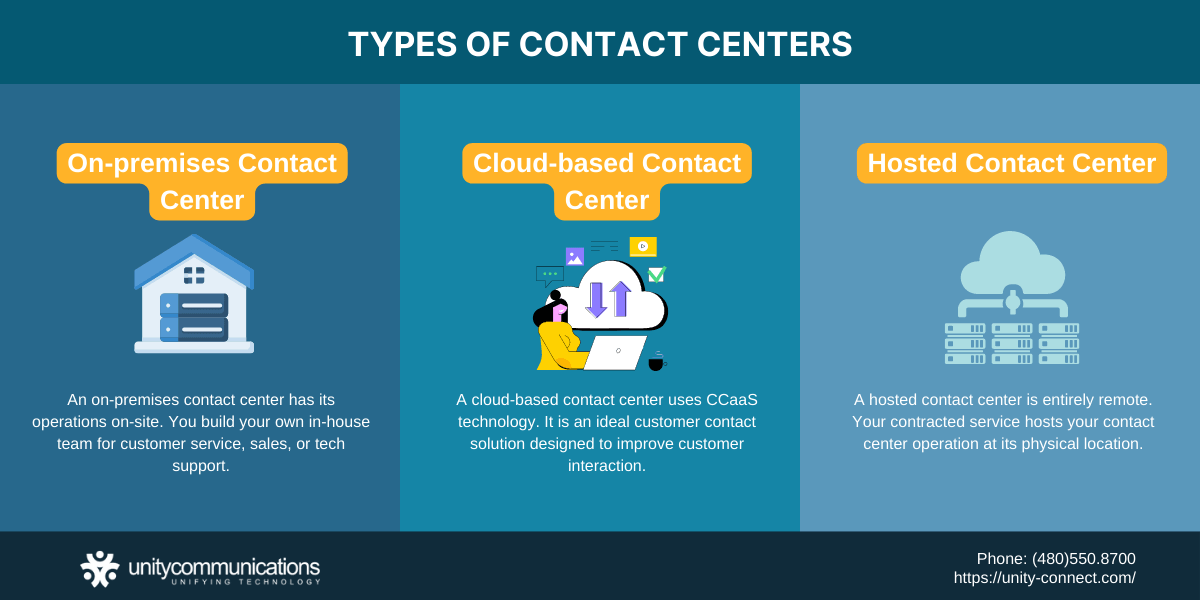Table of Contents
Contact centers require world-class infrastructure to empower agents and enhance customer interaction.
However, some companies lack advanced technology and resources. They neither house state-of-the-art facilities nor use contact center as a service (CCaaS).
Invest in contact center infrastructure (CCI) if you plan to optimize your operations. Read on to learn all about CCI before hiring a provider.
What Is Contact Center Infrastructure?
Contact center infrastructure comprises hardware, software, and telecommunication networks for customer contact. In addition to the front-office workforce, these three components comprise your contact center. The goal is to establish a robust facility with advanced technology to improve customer interaction.
Contact Center Infrastructure Requirements
Based on the definition, CCI has four vital components:
- The hardware consists of tangible components required to set up your contact center. Think of computer devices, phone lines, and physical communications technology. CCI hardware supports local area network (LAN) and computer telephony integration (CTI).
- Software refers to digital tools needed for your contact center operations. Computer applications get installed for customer contact, data management, and business reporting. For CCI software, consider customer relationship management (CRM), quality management systems (QMS), and workforce management systems (WMS).
- A telecommunication network operates your contact center, enabling agent-customer interaction. Voice over internet protocol (VoIP) is an example. It is the most popular telecom network used in contact centers.
- A workforce isn’t necessarily a CCI component. However, customer-facing employees are essential for contact center operations because they work directly with customers. Hence, employ customer-centric agents and tech-savvy IT personnel.
Five Key Features of Contact Center Infrastructure
From $19.5 billion in 2020, the global CCI software market is expected to reach $55.6 billion by 2028 at a compound annual growth rate (CAGR) of nearly 14% from 2021 to 2028. The demand for a personalized experience and streamlined interaction has led to this growth.
Contact center infrastructure investments are best for customer-facing operations. Let’s look at the essential CCI features.
1. Omnichannel Support
CCI offers omnichannel solutions. Before, companies used only one channel, mostly phones, for call centers. Today, 60% of service teams employ more than two channels for customer support. According to Hiver’s 2021 report, below are the communication channels used.
- Phone call: This remains the most popular communication channel. About 83% of customer service teams use voice calls for customer interaction.
- Email: This remains a powerful tool for business and marketing. Also, 77% of teams provide customers with email support.
- Chat: This is a common communication channel for customer service. After phone calls and emails, chat support is at 42%.
- Social media: This has become increasingly popular for customer service. Companies use channels like Facebook, Instagram, Twitter, and LinkedIn for customer engagement.
- Self-service: CCI offers self-service options to customers. Examples are integrated voice response (IVR), chatbots, and frequently asked question (FAQ) pages.
2. Cutting-edge Technology
CCI has some of the most advanced technologies. It doesn’t only incorporate communication channels; it also integrates other digital tools into its facility. Below are some technological resources used in contact center operations.
- CTI: This technology is suitable for call centers. It’s the integration of computers and telephones—hence the name. Agents use computers to communicate and interact with customers.
- CCaaS Software: This software is an ideal solution for contact centers. It’s a cloud-based, provider-hosted infrastructure for customer interaction.
- IVR: This automated system is a self-service portal. Customers can access information and make transactions via this system.
- CRM: This is a central platform for conducting and managing customer interaction. All communication channels are in sync with this unified tool.
- QMS: This system is designed for quality analyst (QA) teams. They use this for data recording and live monitoring.
- WMS: This software is used by workforce analysts for forecasting, scheduling, and monitoring employee availability.
- Web chat platform: This platform enables customer interaction via live chat.
- Email response management system: Customers can contact customer service or support via email with this system.
- Social media: Agents now use Facebook, Instagram, LinkedIn, and Messenger for customer engagement.
3. Seamless Recording and Monitoring
CCI allows data recording and performance monitoring. Think of communication technologies such as CTI and CCaaS. Consider digital tools such as CRM and QMS.
Communication technologies record data such as calls, emails, and chat messages. But while contacts get recorded in real time, QAs can perform live monitoring.
Meanwhile, digital tools store and keep the data securely. They enable QAs to retrieve and review them for performance monitoring.
4. Efficient Analysis and Reporting
Besides recording and monitoring, CCI relies heavily on big data analytics (BDA). Integrated into CCI, BDA assists in business analysis and reporting. This has grown the global BDA market from $2271.83 billion in 2022 to $741.15 billion in 2030 at a 13.5% CAGR.
BDA in CCI includes predictive analytics, whether voice or text. They help workforce analysts forecast the volume of calls or messages. How? The algorithms make predictions based on patterns and trends in recorded data. Ultimately, BDA assists in business reporting and decision-making.
5. Streamlined Technological Integration
Contact centers use various communication technologies and digital tools such as CTI, CCaaS, email management systems, web chat platforms, and social media. They also use applications or software such as CRM, QMS, and WMS.
What CCI excels at is integrating all these tools and technologies. Software, hardware, and telecom networks are all in sync. Contact centers have a centralized platform for customer interaction and data management.
CCI Setup: Types of Contact Centers

Setting up or optimizing your contact center infrastructure is crucial. But first, understand the three types of contact centers. Whether you are building an in-house department or outsourcing to a third party, the type you choose is important.
On-premises Contact Center
An on-premises contact center has its operations on-site. You build your own in-house team for customer service, sales, or tech support.
You purchase the hardware and software required for the operation in this setup. You also tap into a provider for your telecom network. Then, you build the contact center infrastructure.
Sometimes, you can work with a CCI vendor as an on-the-ground solution. Your hired provider builds your infrastructure and provides the technology on-site.
Cloud-based Contact Center
A cloud-based contact center uses CCaaS technology. It is an ideal customer contact solution designed to improve customer interaction.
You do not need to invest in software and networking in this setup. You partly set up your infrastructure and install some hardware, but your vendor provides the software and network hosted in a remote center.
The global CCaaS market might grow from almost $4.43 billion in 2022 to $17.12 billion by 2030 at an 19.1% CAGR. As this market continues to grow, consider capitalizing on it!
Hosted Contact Center
A hosted contact center is entirely remote. Your contracted service hosts your contact center operation at its physical location.
In this setup, your managed service provider (MSP) builds the CCI. They install the hardware, invest in software, and provide the telecom network. They even employ the workforce for your customer-facing functions.
If you lack human and material resources, consider outsourcing your contact center infrastructure and workforce to a third-party vendor.
Five Practical Tips for Hiring a CCI Provider
Now that you fully understand contact center infrastructure, it is time to build or optimize your CCI. Consider hiring a CCI provider for your contact center operations. Here are five practical tips for you:
1. Audit Your Contact Center
Start by examining your contact center operations. If you do not have a contact center yet but have customer-facing functions to operate, set up a CCI.
But if you already run a contact center, audit your current operations to see how you can optimize them. Doing so will help you identify your needs and guide you in hiring a CCI provider.
2. Identify and List Your CCI Needs
The first step helps you identify your CCI needs. However, list all those needs before you search for prospects. For example, jot down the following:
- Use CTI if you run a call center.
- Employ CCaaS if you operate a contact center with multiple channels.
- Invest in a CRM tool if you need to manage customer interaction in one place.
- Use QMS if your QA team needs to improve performance monitoring.
- Use WMS if your workforce analysts need to ensure employee availability.
- Capitalize on BDA if you need support for business forecasting and decision-making.
3. Start Looking for a CCI Provider
After auditing your operations and identifying your contact center needs, begin your search. Note, however, that there are three types of contact centers.
Consider an on-premises contact center if you plan to build an in-house team. But choose a cloud-based contact center if you already have one but want to optimize it. Lastly, a hosted contact center is best if you lack staffing, technology, and resources.
Once you decide on what contact center type to establish, look for a CCI provider. To narrow down your prospects, consider such factors as:
- Technology: Be specific about what technological resources you need for your contact center. (Note: See Cutting-edge Technology discussed above).
- Pricing: Get multiple quotes and compare CCI pricing. Consider how a vendor will reduce your operating costs. Whether an on-premises, cloud-based, or hosted contact center, it should help you save money in the long term.
- Reputation: Of course, reputation matters most when choosing a CCI provider. Check online reviews, including client and customer feedback.
4. Set up Your Contact Center Infrastructure
Now, you can work with your provider and set up your CCI. You must purchase software and hardware licenses if you choose an on-premises solution. Then, have your hired vendor or IT staff set them up in your business location.
If you opt for a cloud-based solution, hire the right CCaaS provider. Let them set up, install, and host your contact center operation. But if you’re starting from scratch, consider working with an MSP. They will help run your contact center operation.
5. Optimize Your Contact Center Operations
At this point, you can now kick off your customer contact operations. But the work does not end here. Make sure to optimize your contact center. Here are a few recommendations for CCI optimization:
- Employ omnichannel solutions.
- Offer self-service options.
- Use computer telephony integration (CTI).
- Use artificial intelligence (AI).
- Incorporate big data analytics (BDA).
- Integrate other digital tools.
- Conduct regular CCI audits.
- Hire MSP or employ IT support personnel
The Bottom Line
The moment has arrived to refine your contact center operations. Whether it’s constructing or expanding your contact center infrastructure, the key is to identify and engage with the most fitting CCI (Contact Center Infrastructure) provider that aligns with your unique customer interaction needs.
Embarking on setting up your CCI involves addressing various elements such as hardware, software, network capabilities, and workforce dynamics. Additionally, integrating the five CCI features we’ve recommended earlier is crucial. Above all, don’t overlook the practical advice we’ve shared for enhancing your contact center operations.
By establishing a top-tier CCI, you empower your agents and streamline your processes. This advancement is pivotal in elevating the customer experience and boosting your company’s financial performance. For tailored assistance in achieving these objectives, we encourage you to contact Unity Communications.




